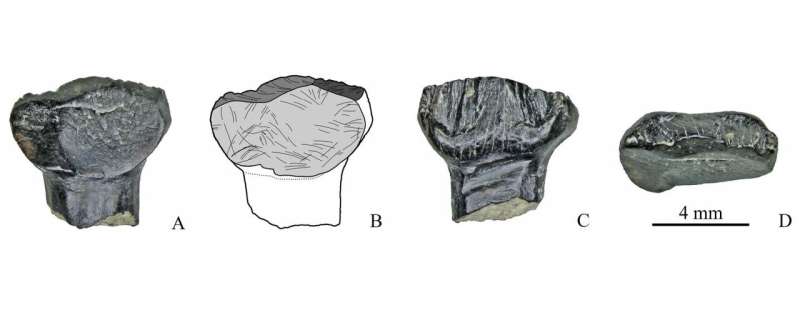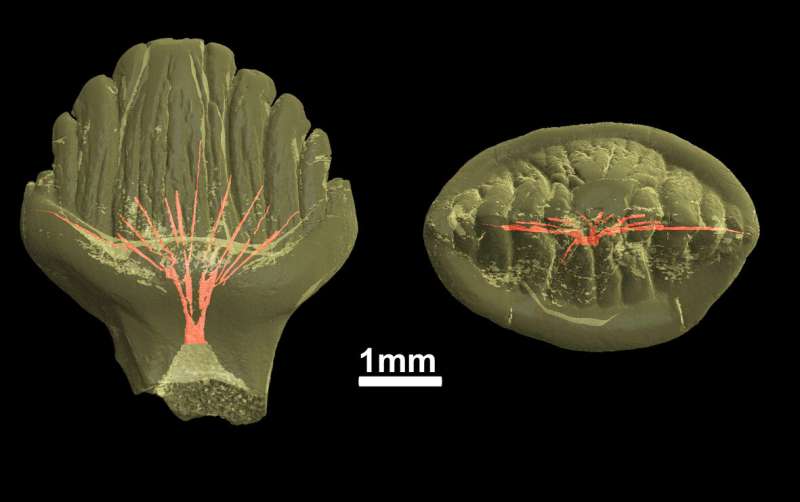Scientists examine more than 60 teeth of stegosaurs from Yakutia

Powerful and squat stegosaurs are now one of the most recognizable dinosaurs: they are easily identified by the spines on the tail and the bony plates on the back—osteoderms. The representatives of this group lived about 165-125 million years ago, during the Jurassic and early Cretaceous periods. They were five to seven meters long and had a disproportionately small head. Their teeth were therefore quite small—about a centimeter in height and about the same in width.
Paleontologists from St Petersburg University worked together with colleagues from: the Zoological Institute of the Russian Academy of Sciences; the Borissiak Paleontological Institute of the Russian Academy of Sciences; the University of Bonn; and the Diamond and Precious Metal Geology Institute of the Siberian Branch of the Russian Academy of Sciences. The research materials were collected during a series of expeditions to the Republic of Sakha in 2012 and 2017-2019. On the banks of the Teete stream, not far from the small Yakut town of Suntar, there is a large, but not yet fully examined locality of dinosaurs. In the Cretaceous, these territories were located close to the North Pole, which means that they can shed light on the life of polar dinosaurs. Was the local fauna different from that of the southern regions? What was the climate here? How were animals affected by the polar day and polar night? The scientists are trying to find answers to these questions, including by studying the teeth of ancient creatures.
"We have found teeth of animals of different ages—both adults and cubs," said Pavel Skutschas. "This suggests that the polar stegosaurs are most likely to have been sedentary: they multiplied and raised offspring on the same territory all year round. Additionally, almost all of the finds are extremely eaten away: many of them have two or three facets—worn edges from contact with adjacent teeth."
This feature prompted the researchers to believe that second dentition in polar stegosaurs could occur sufficiently quickly. The scientists therefore investigated 'temporary rings' - the so-called von Ebner lines, which can be used to calculate the number of days required for odontogenesis. It took Yakut stegosaurs only about 95 days to complete this task, although in other dinosaur species the process usually lasted 200 days or longer. These Yakut inhabitants are most likely not to have suffered from caries since it takes much more time for it to appear.
"The fact that teeth formed quickly, grinded quickly and changed quickly is highly likely to indicate that the stegosaurs from Yakutia ate some kind of tough food. We cannot yet say with 100% certainty that we have found polar adaptation, since there is, in principle, very little information about the teeth of stegosaurs. However, their teeth, found in more southern areas, usually have only one wear surface. In a word, this is a new question for palaeobotanists—what was the hard plant growing in the polar regions that the Yakut stegosaurs ate?" noted Pavel Skutschas.
Another remarkable thing made it possible to take a different view on the structure of the jaws of these animals: on the surface of the teeth abrasion, the scientists were able to spot curved micro gouges. Paleontologists used to assume that very simple jaw movements were characteristic of stegosaurs—up and down, like scissors. However, now, thanks to the patterns of gouges on the facets, it became clear that jaw movements were more complex and included a longitudinal phase.

Another conclusion turned out to be associated with the wavy structure of the enamel. It used to be thought that it was unique to the younger Late Cretaceous dinosaurs, which had a complex dentition, such as the hadrosaurids. However, the paleontologists saw this feature in stegosaurs from Yakutia and decided to examine the teeth of another Early Cretaceous dinosaur, a primitive relative of Triceratops—Psittacosaurus. This unique feature turned out to have been prevalent among dinosaurs in general.
"Stegosaurs are one of the most recognizable and popular dinosaurs that are often seen on T-shirts and various pictures. However, we still know little about them. This research has raised many new questions that can be solved without setting out on an expedition, but by studying materials that have been stored in museums for hundreds of years. We have managed to show what features the polar stegosaurs had. But what is an "ordinary," "benchmark" stegosaurus? This has yet to be investigated," stressed Pavel Skutschas.
More information: Pavel P. Skutschas et al, Wear patterns and dental functioning in an Early Cretaceous stegosaur from Yakutia, Eastern Russia, PLOS ONE (2021). DOI: 10.1371/journal.pone.0248163
Journal information: PLoS ONE
Provided by St. Petersburg State University





















